ISSN 2348-1196 (print)
International Journal of Computer Science and Information Technology Research ISSN 2348-120X (online) Vol. 8, Issue 2, pp: (62-73), Month: April - June 2020, Available at: www.researchpublish.com

ISSN 2348-1196 (print)
International Journal of Computer Science and Information Technology Research ISSN 2348-120X (online) Vol. 8, Issue 2, pp: (62-73), Month: April - June 2020, Available at: www.researchpublish.com
1,2,3,4
Abstract: This paper proposes a conceptual solution to help underprivileged children aged from 4 to 12 years old in primary education that come from low-income families and rural areas to have access to quality education through a virtual learning platform. Virtual Learning Hub System (VLHS) is a digital platform which provides a digital platform for teachers to perform teaching and learning activities with underprivileged children without having to share an actual physical classroom. This business model also focuses on providing multiple opportunities to customer segments that includes underprivileged children, teachers and third-party tuition services. It is also in line with Sustainable Development (SDG) Goal 4 that aims to ensure inclusive and equitable quality education and promote lifelong learning opportunities for all. Factors such as financial instability and geographical boundaries are one of the few reasons why these children do not have the opportunity to learn. This paper offers validated conceptual Malaysian University-of-the-Future (UotF) business model with focus on community engagement programmes in Malaysia. The value proposition of the conceptual business model is to enhance the wellbeing of Malaysian children through humanising digital education activities and harnessing the digital capability. The design and system thinking approach has been adapted in this paper to address the wellbeing issues of B40 children in Malaysia through understanding their needs, and then followed by building conceptual business models using modelling tools such as Business model canvas (BMC) and Value proposition design canvas (VPC). The approach includes conducting literature review and interviews for understanding the needs, challenges and key problems; formulating and ideating initial business model options in solving the problems; and validation of the initial business model by interviewing the various customer segments.
Keywords: Wellbeing, Access to education, Community engagement, Underprivileged children, SDG 4, Rural areas, Digital learning platform, Business Model, UotF.
The main hope of a nation lies in the proper education of children. Education helps one in problem solving and decision making as it broadens one way one thinks. It also provides the flexibility to differentiate between what's right and wrong, what's immoral and ethical. In Malaysia, 40 percent of the population comprises B40 population with an average household income below RM 3860, these low-income groups consist of rural people who are unable to access the
ISSN 2348-1196 (print)
International Journal of Computer Science and Information Technology Research ISSN 2348-120X (online) Vol. 8, Issue 2, pp: (62-73), Month: April - June 2020, Available at: www.researchpublish.com
facilities provided by the government due to their faraway residence and lack of access to special education (Faculty of Education UKM, 2019). Regrettably, this can impact the learning process of basic numeracy and literacy of children in the family.
This paper proposes a conceptual solution to help underprivileged children that come from low-income families to have access to quality education through a virtual learning platform. Virtual Learning Hub System (VLHS) allows educational/learning environments to be developed as well as creating a communication, interaction and education management platform. The implementation and discussion aimed at next-generation school education have recently become more relevant. With the advancement of information technology, the usage of digital textbooks and e-learning platforms has gradually increased (Habib Fardoun, 2012).
There are numerous benefits and advantages of online learning. According to Rachel Gillet (2014), 65% of people are visual learners, one of the best ways to deliver messages is through visual content. Besides that, online learning also has a better availability as it offers flexibility to learn wherever and whenever you are comfortable (Tania Heap, 2017). Massive open online courses are considered to be the next frontier of education. It is expected to increase access, lower the cost of delivery, bring Malaysian expertise to the world, and enhance the branding and visibility of Malaysian higher education institutions (Chang Da Wan, Morshidi Sirat, Dzulkifli Abdul Razak, 2018). VLHS enables children to have access to educational content, to communicate with their tutors through easy access. The system scope is mainly for poor underprivileged children that can’t afford financially and live in rural areas.
Education is one of the most fundamental aspects in unlocking one’s full potential. Unfortunately, the poorest children in Malaysia’s capital suffer educational barriers (Louisa Kendal, 2018). Education cost is rising in Malaysia and these unprivileged children who come from a low-income family - B40 would struggle without any financial aid as they cannot afford it as a whole, many parents have to take cost-effective measures to ensure their children are able to pursue their education (Marcella Gider October, 2019). For teachers, the travelling journey involved to teach students can be tiring and time consuming in the process (Arun P. Bali). For third-party tuition services, attracting new market segments and exposing their brands to potential customers is a strong motivation, particularly those struggling with exposure (Oscar Lima Silva & Jose Duarte Santos, 2019). To solve this issue, a solution to facilitate the process of teaching balanced education to these underprivileged children is proposed in this paper. This solution would allow communication/education activity to take place between students and teachers virtually through the internet. Through this way it can provide a convenient and easy access platform to education resources. Third-party tuition services too can use this platform to post advertisements about their educational teaching service and attract more customers from time to time.
The main objective of this study is to reduce the poverty rate by increasing the knowledge and skills of the children in the poor community in conjunction with IIUM. It is intended to help the wellbeing of underprivileged children aged from 4 to 12 years old in primary education that come from low-income families and rural areas to have access to quality education through digital education activities. Children who are lacking exposure to quality education would affect their growth in the long run and with this platform it would allow communication/education activity to take place between students and teachers virtually through the internet. This is to ensure inclusive and equitable quality education and promote lifelong learning opportunities for all. This business model also focuses on providing multiple opportunities to other customer segments as well which are volunteer teachers by helping to create and enhance their teaching career and third-party tuition services by providing a marketing platform to grow their business. This solution is expected to open the gate of opportunities to this targeted audience for them to learn knowledge and enhance their skills in a comfortable manner
This paper adopted the design and system thinking approach to develop a conceptual business model of a Malaysianbased UotF focusing on implementing relevant international community engagement programmes and activities. The value proposition of the conceptual business model is to enhance the wellbeing of B40 children in Malaysia through humanising entrepreneurship education, and by harnessing the use of digital/IR4.0 capability and platform. The conceptual business model is developed through understanding the needs of B40 children by using business modeling tools such as Business Model Canvas (BMC) and Value Proposition Design Canvas (VPC).
ISSN 2348-1196 (print)
International Journal of Computer Science and Information Technology Research ISSN 2348-120X (online) Vol. 8, Issue 2, pp: (62-73), Month: April - June 2020, Available at: www.researchpublish.com
Business Model Canvas (BMC) (Osterwalder, Pigneur & al. 2010) is divided into 9 blocks which are Key Partners, Key Activities, Key Resources, Value Proposition, Customer Relationships, Channels, Customer Segments, Cost Structure and Revenue Stream. Value Proposition Canvas (VPC) (Osterwalder, Pigneur & al. 2010) are used to analyze value propositions in relation to customer segments and help to systematically analyze their needs and requirements. The approach involves carrying out online surveys and literature review to identify key challenges and issues of various customer segments, formulating and devising an initial conceptual business model – in the form of BMC and VPC, and value proposition to enhance the wellbeing of B40 students/children in Malaysia. The initial BMC and VPC is validated by conducting an online survey for various customer segments which are volunteer teachers and third-party tuition services through a series of standardized questions using Google Form. It is a convenient way to reach out to the respondents as it is less time-consuming than the traditional way of gathering information through one-to-one interactions, and less costly.
Design thinking is a methodology that uses the intuition and techniques of the designer to match the needs of people with what is technologically workable and what a viable business plan can turn into value for the customer and opportunity in the market. The literature review is a comprehensive summary of previous research on a topic. The literature review surveys scholarly articles, books, and other sources relevant to a particular area of research. The review should describe, summarize and evaluate this previous research. It should give a theoretical base for the research and help to determine the nature of research. It is a way to give some basic understanding of the materials chosen. Benchmarking is also used in the process of comparing our operations or processes of organization against other platforms with the same educational concept. It can be applied with any products, strategies or approach in business. It is a very important component because with benchmarking, we can identify the weakness and improve our performance of our business.
Access to education to all individuals in the community ensures the 4th Goal of SDG which is to promote lifelong learning opportunities for all and equitable quality education. The United Nations claims that in 2019,262 million children aged 6 to 17 were still out of school in 2017, and more than half of children and adults are not meeting minimum proficiency standards in reading and mathematics. Based on the press release of children statistics by the Department of Statistics Malaysia, it says “Enrollment in government and government-aided schools dropped 45 thousand from 2016 to 2017. The decrease was attributed largely by the intake decline of lower secondary and upper secondary. Concurrently, primary enrollment also decreased 5.2 thousand to 2,678.6 thousand as compared to previous year”. Through education, it would create job opportunities for these children when they grow up which promotes economic growth, productive employment and decent work for all (SDG 8). With stable economic growth and employment, it would indirectly help in achieving the 1st Goal of SDG which is ending poverty. This is to ensure social protection for the poor and vulnerable and increase their access to basic services and support. Other than that, it also promotes wellbeing as it allows people to achieve universal health coverage, including financial risk protection, access to quality essential health-care services and access to safe, effective, quality and affordable essential medicines and vaccines for all (SDG 3). (United Nations. Sustainable Development Goals. sustainabledevelopment.un.org/sdgs, Department of Statistics Malaysia. https://www. dosm.gov.my/).
Technology offers multiple great ways to convey information from one side to another. It has become an integral part in education as it is used in both teaching and learning processes. It is a medium that supports learning 24 hours a day and is able to increase student engagement and accelerate learning. For example, numerous full-time online schools in other countries; United States: Florida Virtual School, Karval Online Education, North Carolina Virtual Public School and etc. These students receive all of their instruction and earn all of their credits through online school. The key features of the platforms include blended learning opportunities that involve both face-to-face and open educational material/resources. It helps especially in rural areas where blended or online learning can help teachers and students in remote areas overcome distance boundaries. (U.S Department of Education. Use of Technology in Teaching and Learning. ed.gov/oii-news/usetechnology-teaching-and-learning).
ISSN 2348-1196 (print)
International Journal of Computer Science and Information Technology Research ISSN 2348-120X (online) Vol. 8, Issue 2, pp: (62-73), Month: April - June 2020, Available at: www.researchpublish.com
A Delhi based non-profit NGO launched virtual classes in Bihar which is a state in East India. Their aim is to provide quality education to more and more underprivileged children who cannot physically attend schools. It includes interactive classes where teachers and the coordinators login from all across the country and easily interact with children and provide them the right training in all subjects. It has received excellent response as students and their parents are happy as they can get the best teachers to get expertise training and exposure. (India Today, 2019. indiatoday.in/educationtoday/news/story/virtual-classes-underprivileged-children-quality-education-divd-1625351-2019-12-05).
Universities are well-known place for higher level studies around the world. This is where students create, make and think for the future. The education system need to prepare for technologies that have yet to be invented, and find solutions to problems that have yet to be encountered, the focus should be on the preparedness of the education institutions to embrace these challenges in making use of the digital and IR4.0 technologies in their day-to-day operations (Ibrahim & Dahlan, 2016; Dahlan et al., 2020; Zakri Abdul Hamid, 2019). Based on several crucial concepts such as agility, universities can pave out their own way towards this revolution. To make sure this revolution goes well, universities should concentrate on turning themselves into a platform that allows students to learn from multiple sources such as professors, open source content, industry professionals, alumni, etc. and create a culture of creativity and analytical attitude.
Taylor’s School of Education under Taylor’s University started an initiative to supplement children within the B40 to M20 group with free e-learning materials. Dr Logendra Stanley, together with a team of lecturers reached out to students with limited learning resources. They developed a series of videos in the national language delivered to the B40 to M20 group. Among the lessons provided include basic English, Mathematics, and Science for school children. The educational videos have been shared to as many as 43 families via WhatsApp and Telegram channels. The initiative is well-received by all of the families as they found the content insightful, with the Parent’s Involvement Module receiving the best response followed by Maths, Science, and English. The recipients also appreciate the content as parents can now be involved in the children’s learning. (Taylor’s University - university.taylors.edu.my).
Khan Academy is an online platform tool that offers practice exercises, instructional videos, and personalized learning that gives students a chance to study at their own pace outside of the classroom. It offers courses on math, science and engineering, computing, arts and humanities, economics and finance. Khan Academy is adapted for early education and even has the Khan Academy Kids for children. Khan Academy Kids is a free, fun, educational program designed to inspire young children to through quality education that covers several topics. The program contains learning materials such as math, language arts, and social-emotional learning for children. This platform is free of charge.
Skillshare is an online learning community where anyone can discover, take, or even teach a class. Anyone can join it to start watching online classes, create projects, and even become a teacher. This platform started to close the professional skills gap and provide universal access to high-quality learning. This teacher and student platform provide users the opportunity to access content, presentations, and courses related to a wide variety of topics. These topics include technology, writing, crafts and more. Professionals who are using the platform as instructors can teach skills by creating and publishing classes.
This online platform is targeted towards primary-aged children and offers courses designed to boost maths, reading and science comprehension that complement early studies. It is a non-profit organization providing free, fun, curriculumbased quality primary education to all children world-wide. The courses are free and are offered in five different languages. This E-Learning platform is entirely funded by the donations of sponsors and organizations.
ISSN 2348-1196 (print)
International Journal of Computer Science and Information Technology Research ISSN 2348-120X (online) Vol. 8, Issue 2, pp: (62-73), Month: April - June 2020, Available at: www.researchpublish.com
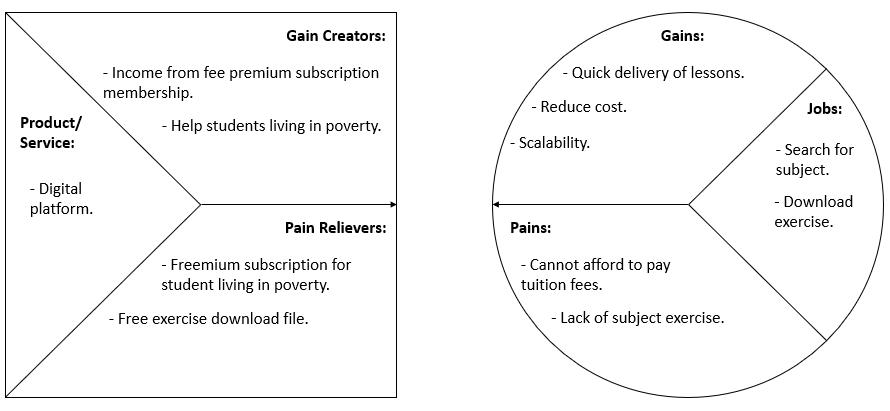
1. Initial Business Model Canvas (BMC)
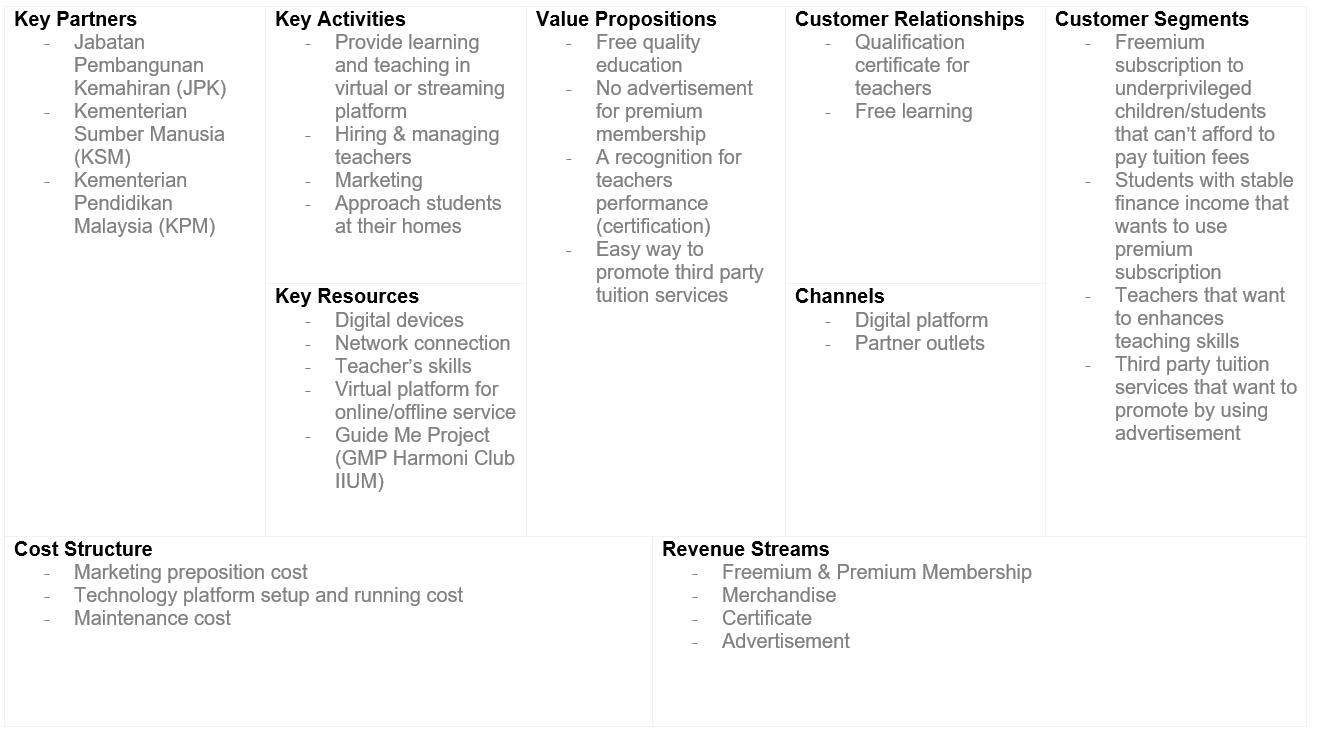
Fig 1: Initial Business Model Canvas
2. Initial Value Proposition Canvas (VPC)
Fig. 2: VPC for Students
Fig 3: VPC for Teachers
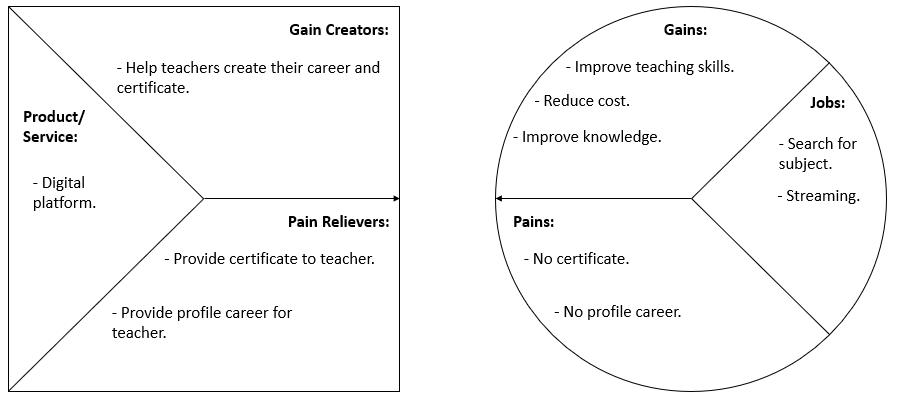
ISSN 2348-1196 (print)
International Journal of Computer Science and Information Technology Research ISSN 2348-120X (online) Vol. 8, Issue 2, pp: (62-73), Month: April - June 2020, Available at: www.researchpublish.com
Fig. 4: VPC for Third-party Tuition Services
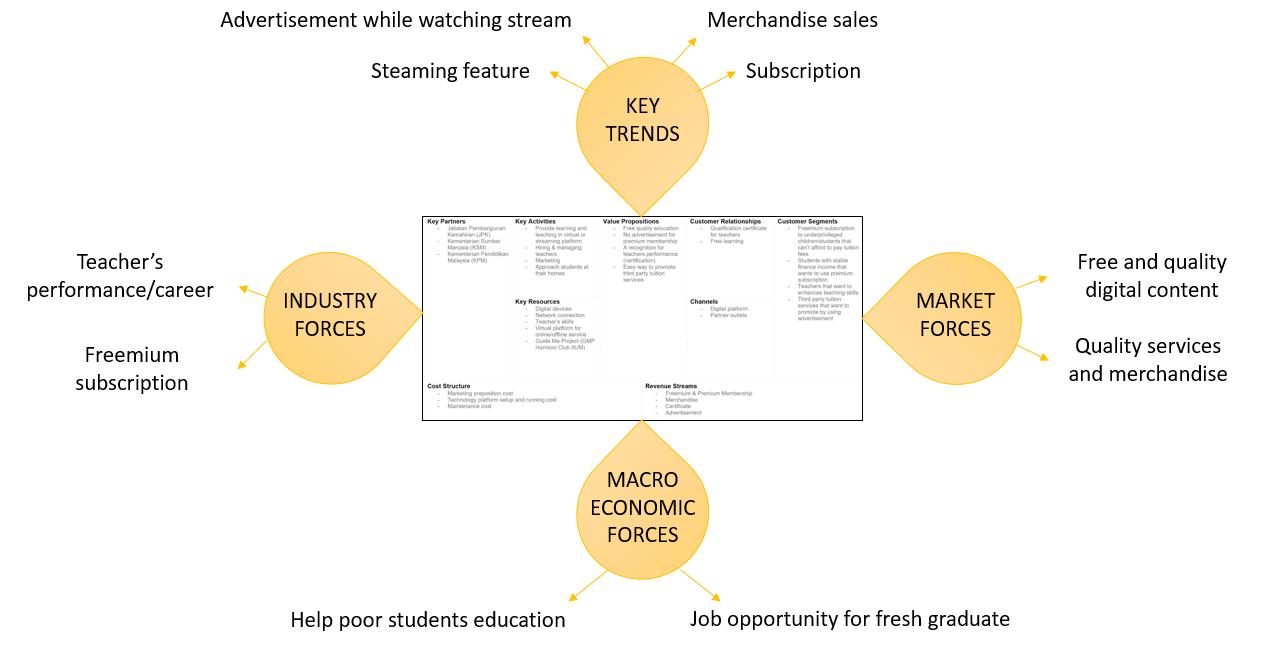
3. Initial Environment Map (EM)
Fig. 5: Initial Environment Map
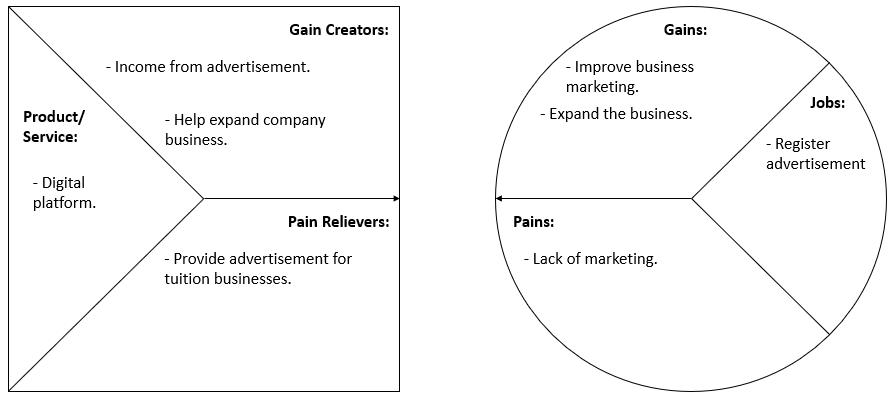
We have conducted an online survey to validate and refine our business plan. Below is the visual feedback that we have received from the Google Form survey. For the first question, we asked users if they would agree that an online learning platform can assist in making the teaching process easier. We found that 77.8% agreed that it would ease the process while 22.2% said maybe.
Fig. 6: Teaching process assistance
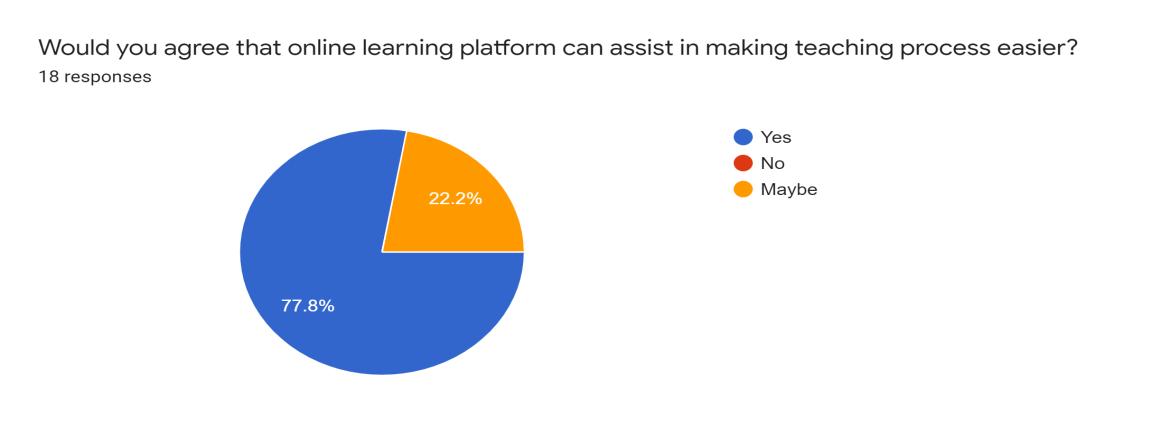
ISSN 2348-1196 (print)
International Journal of Computer Science and Information Technology Research ISSN 2348-120X (online) Vol. 8, Issue 2, pp: (62-73), Month: April - June 2020, Available at: www.researchpublish.com
For the second question, we asked whether teachers would use this platform in order to deliver education and skills to these B40 children voluntarily. The result showed that 94.4% percent of them responded yes while 5.6% responded otherwise.
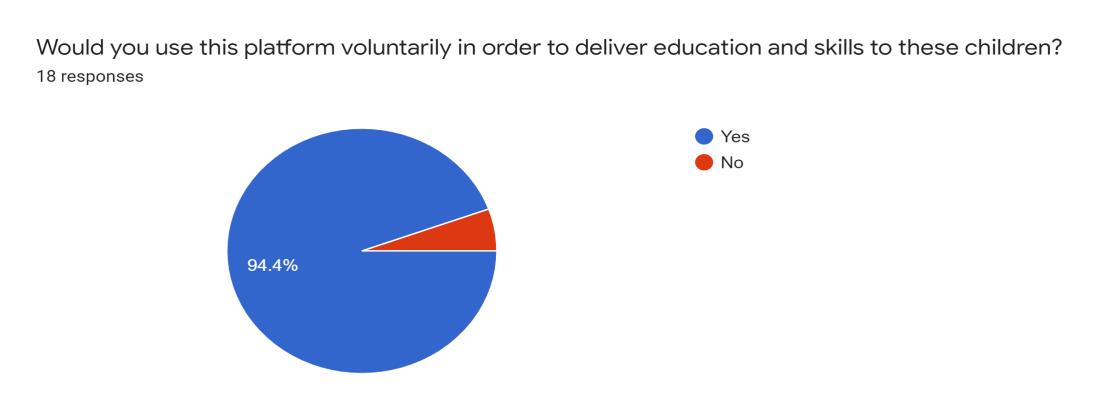
Furthermore, the next question we asked if an organization intends on switching to online/distance learning, what would be the main challenge. Based on the feedback, the main challenge would be internet stability - 83.3% followed by computer literacy - 50%. Other than that is time management - 38.9% and lastly self-motivation - 22.2%
Furthermore, we enquired on what would most help teachers in order to conduct distance learning. 77.8% of respondents chose video clips/lesson plans on conducting online classes while 61.1% of them chose easy contact with experts to assist such as an experienced online-learning teacher.
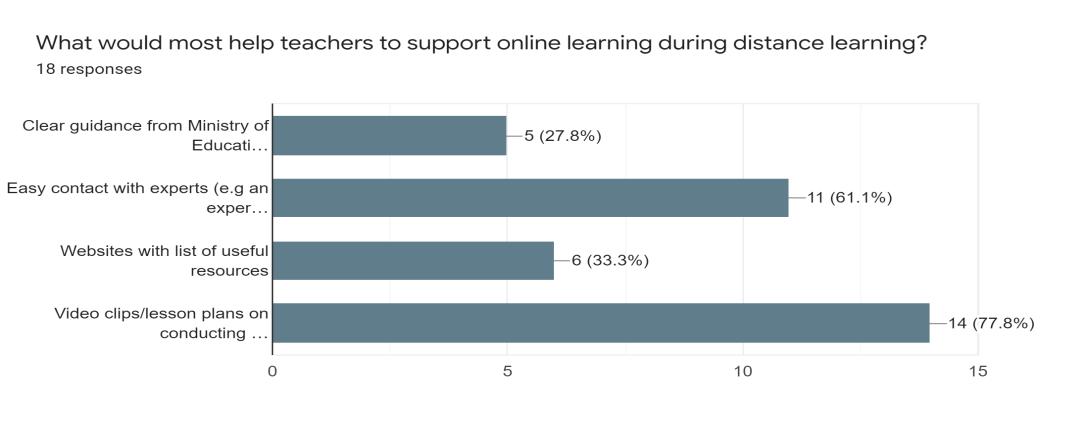
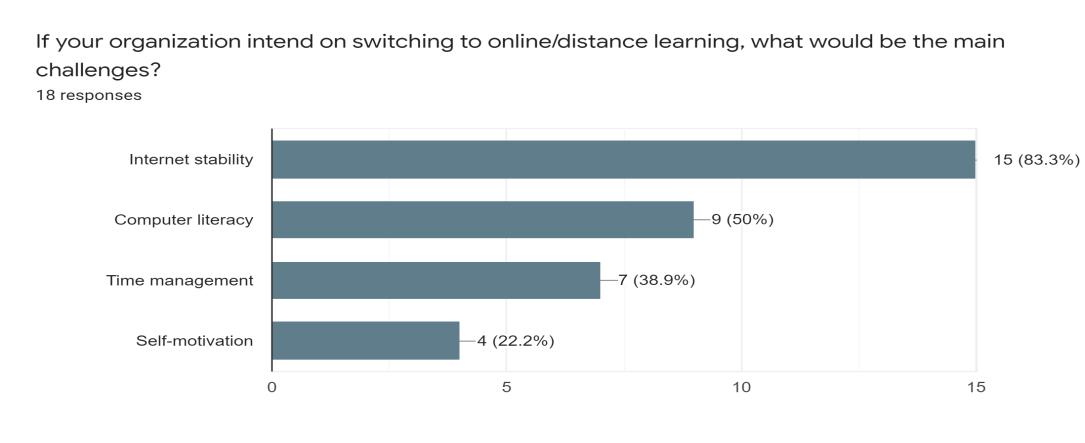
ISSN 2348-1196 (print)
International Journal of Computer Science and Information Technology Research ISSN 2348-120X (online) Vol. 8, Issue 2, pp: (62-73), Month: April - June 2020, Available at: www.researchpublish.com
On top of that, we asked whether including advertisements on the online platform would help in business growth for third-party tuition services in attracting customers/students. The result showed that 94.4% agreed that it would help while 5.6% said no.
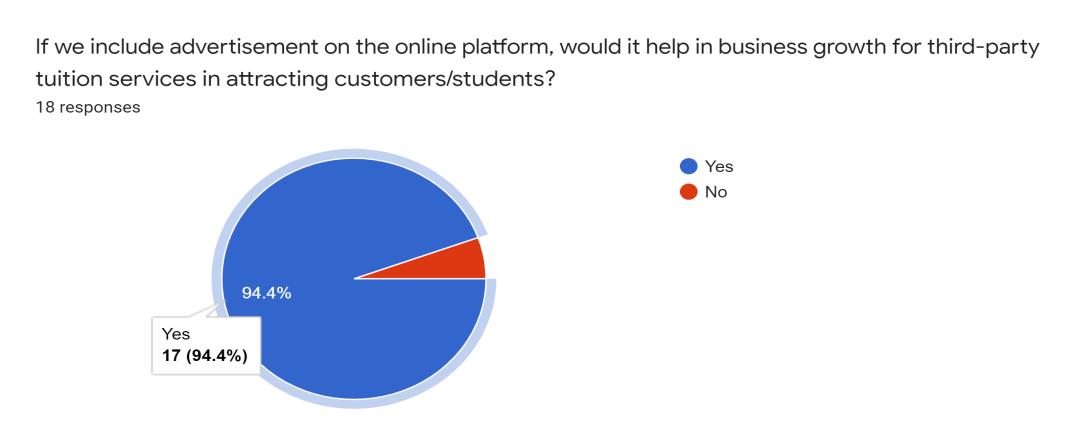
Lastly, we also include a question asking on what aspect would advertisement help in growing third-party tuition services most. 72.2% responded with business exposure and marketing and 27.8% said it would lift the brand image of tuition service.
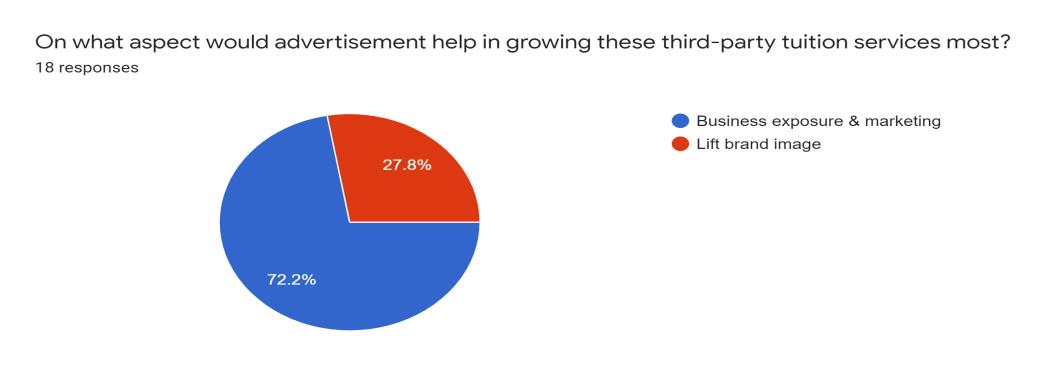
Fig. 11: Advertisement help aspect
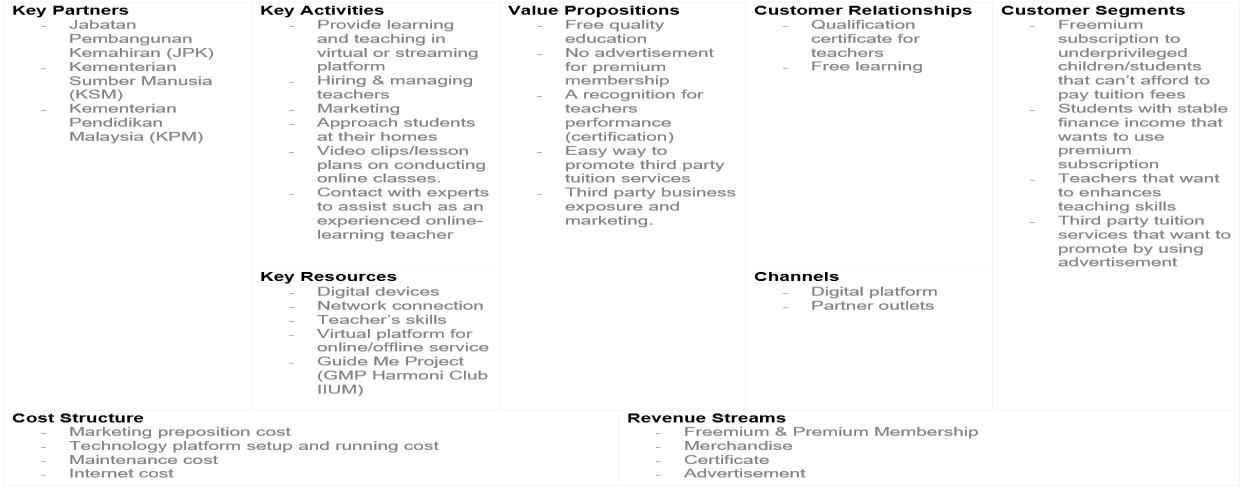
1. Enhanced Business Model Canvas (BMC)
Fig. 12: Enhanced Business Model Canvas (BMC)
ISSN 2348-1196 (print)
International Journal of Computer Science and Information Technology Research ISSN 2348-120X (online) Vol. 8, Issue 2, pp: (62-73), Month: April - June 2020, Available at: www.researchpublish.com
The Value proposition is a service, or benefit that is offered in order to satisfy the needs and requirements of customer segments. The values offered to each type of customers is specified below:
a. Underprivileged children aged from 4 to 12 years old (primary school education): Freemium subscription access to quality education and learning activities through the internet (virtual learning). By providing this freemium subscription, underprivileged students can also get to study and have balanced education as others. Features such as virtual libraries for materials, course exercises and also discussion boards that allow children to participate in discussions facilitated by teachers.
b. Students with stable income: Premium subscription access to learning activities without advertisements on the platform. While the numbers of students with stable income increase, the request for teachers will also increase and surely it will enhance the employment opportunity.
c. Volunteer Teachers: Recognition of performance through certification given and accredited by Jabatan Pembangunan Kemahiran (JPK) and Kementerian Sumber Manusia (KSM). This feature would allow volunteer teachers have the opportunity to serve and earn the credits. It can enhance employment opportunities for fresh graduates for them to create and improve their career.
d. Third-party tuition services: Trusted digital platform to promote their tuition services offering courses through advertising. For example, while having an online teaching process, advertisement would popup for non-premium subscription.
Customer Segments defines the groups of people or organizations we aim to reach or serve. The business model focuses on customer segments that include: Underprivileged children/students, students with stable income, volunteer teachers and third-party tuition services. Retrenched graduates can take this opportunity to train under key partners to be a qualified teacher.
Customer relationships describes the type of relationship we want to establish with specific customer segments. The relationship for this business model is built based on virtual free learning activities and the certifications given to teachers certified by rightful government departments. Besides that, third-party tuition services could use this platform to attract customers to their own service as well by advertising. The advertisement can be posted by contacting the technical development team face to face to organize effectively.
Channels describes how we plan to reach out and communicate customer segments to deliver the value proposition. The channels include the use of social media and emails. Key features of Virtual Learning Hub System such as open source educational material, remote teacher online, teaching certification etc. Partner outlet is also used particularly to reach out to these underprivileged children face to face who live in rural areas.
This section describes the important key activities to be performed in order to deliver the value propositions to the customer segments. The key activities include developing, maintaining and providing a virtual learning and teaching platform. Apart from that is hiring and managing qualified volunteer teachers, reaching out to the underprivileged children and marketing. Lastly, managing communication with key partners and customer segments.
Key resources are the important assets required to make sure the value prepositions can be delivered to each customer segment. Digital devices with good network connection such as computers or tablets needed to be installed at respective children’s houses. Other than that, is selecting teachers who have qualification and expertise to teach subjects, and the virtual platform itself that is able to operate through the internet and a partner outlet to reach out to the children. The partner outlet is Guide Me Project (GMP), GMP is an initiative movement under Harmoni Club IIUM. The main
ISSN 2348-1196 (print)
International Journal of Computer Science and Information Technology Research ISSN 2348-120X (online) Vol. 8, Issue 2, pp: (62-73), Month: April - June 2020, Available at: www.researchpublish.com
objective of GMP is to provide education assistance to the children of Projek Perumahan Rumah Transit (PPRT) situated in Batu Caves, Gombak through free tuition classes, as well as to build spiritual community through series of lectures and other community programs. For other places, this business model can be applied by cooperating with local state NGOs that focuses on delivering education for children.
This section describes the external partners or organizations who can collaborate as partners to execute and deliver the value propositions. The key partners include government departments such as Jabatan Pembangunan Kemahiran (JPK), Kementerian Sumber Manusia (KSM) and Kementerian Pendidikan Malaysia to support funding and training.
The cost structure defines the costs needed in order to execute and deliver the goal. This includes the cost executing activities of marketing and advertisements, hiring and managing teachers, technological platform setup and maintenance.
The revenue stream comes from the customer segments. The purpose is to cover the cost of operations mentioned in the cost structure. The revenue streams include freemium & premium membership fees, selling of stationery merchandise, payment to obtain certificate from teachers and advertisement fee from third-party tuition services.
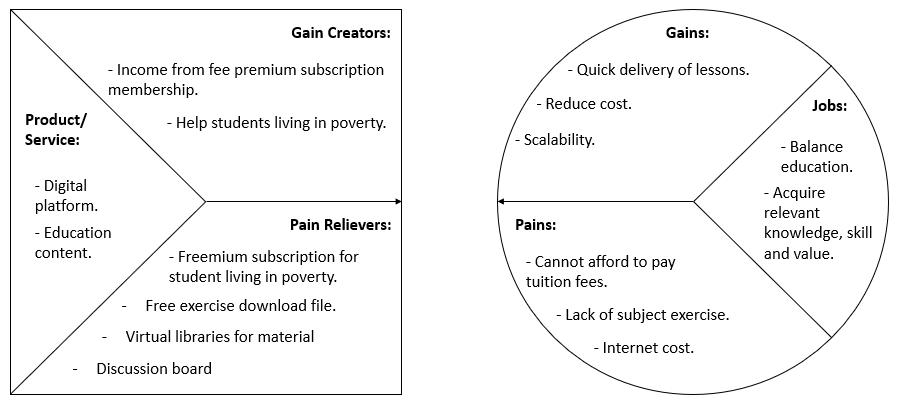
2. Enhanced Value Proposition Canvas (VPC)
Fig 13: Enhanced VPC for Students
Fig. 14: Enhanced VPC for Teachers
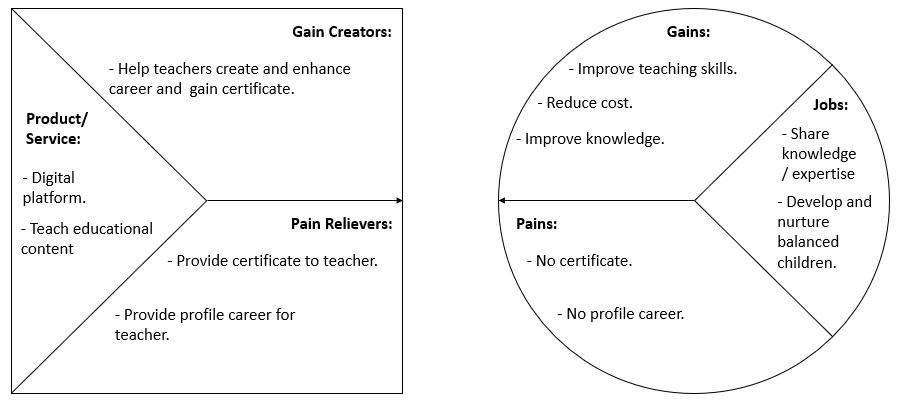
ISSN 2348-1196 (print)
International Journal of Computer Science and Information Technology Research ISSN 2348-120X (online) Vol. 8, Issue 2, pp: (62-73), Month: April - June 2020, Available at: www.researchpublish.com
Fig. 15: Enhanced VPC for Third-party tuition services
3. Enhanced Environment Map (EM)
Fig. 16: Enhanced Environment Map
This conceptual business model would give numerous benefits and opportunities to customer segments that includes underprivileged children, teachers and third-party tuition services. The underprivileged B40 children would be able to have beneficial learning opportunities and educational resources in aim to ensure inclusive and equitable quality education and at the same time enhance their wellbeing through humanising digital education activities. For volunteer teachers they would be able to gain valuable experience teaching virtually and obtain teaching certificates authorized by the rightful authorities and at the same time help in creating and enhancing their career of employment. Third-party tuition services are able to have marketing platform in promoting their businesses to the market. For future work, a project management plan (PMP) shall be developed to implement and realise this conceptual VLHS business model.
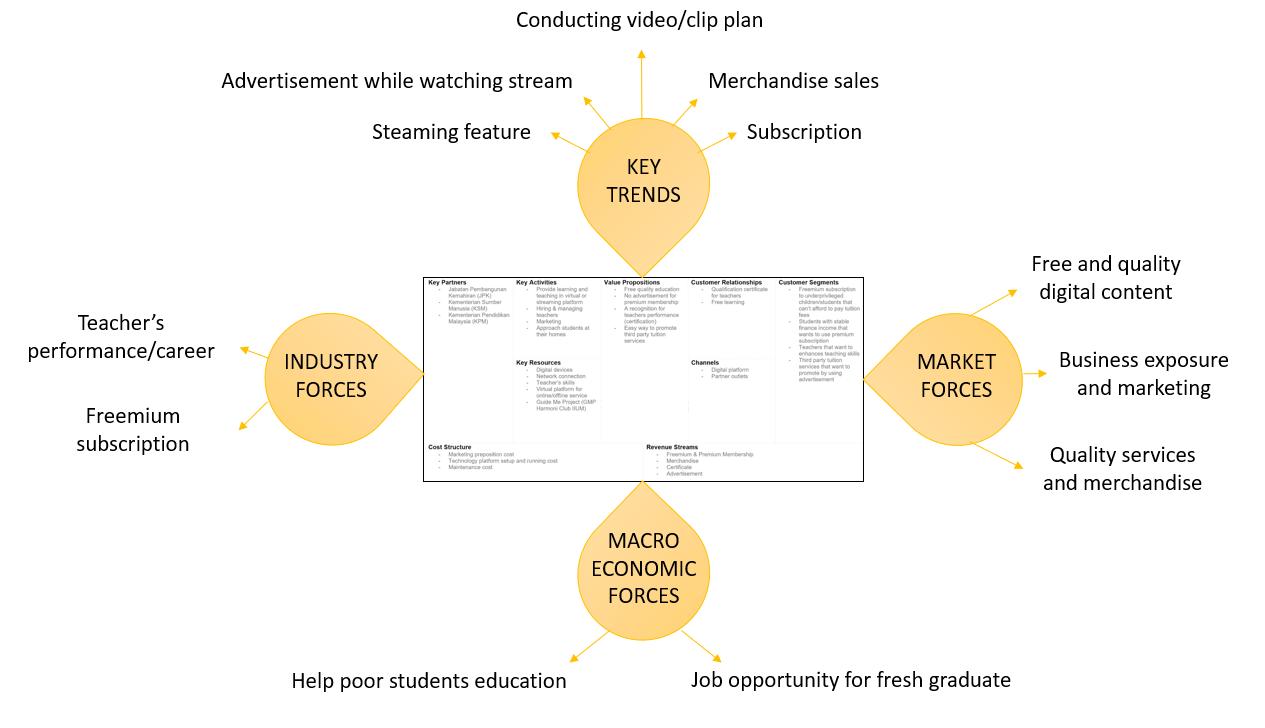
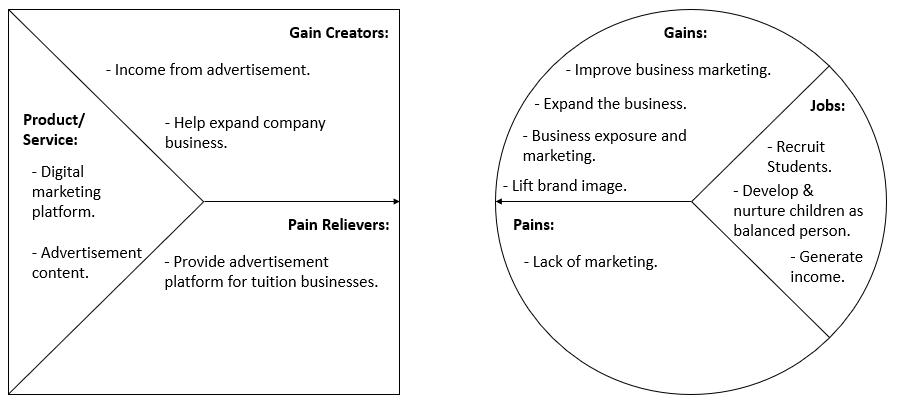
ISSN 2348-1196 (print)
International Journal of Computer Science and Information Technology Research ISSN 2348-120X (online) Vol. 8, Issue 2, pp: (62-73), Month: April - June 2020, Available at: www.researchpublish.com
[1] Alice. (2020, February 13). This Veteran Is Bringing Virtual Education to Underprivileged Students. Retrieved from: https://blog.helloalice.com/this-veteran-is-bringing-virtual-education-to-underprivileged-students/amp/
[2] Kendal, L. (2020, March 19). Online education is increasing opportunities for disadvantaged students. Retrieved from: https://www.studyinternational.com/news/online-education-increasing-opportunities-disadvantaged-students/
[3] Desk, I. T. (2019, December 05). This foundation has launched virtual classes for underprivileged children to provide quality education. Retrieved from: https://www.indiatoday.in/amp/education-today/news/story/virtualclasses-underprivileged-children-quality-education-divd-1625351-2019-12-05
[4] Balajee Sewa Sansthan. E- learning centre For Underprivileged Children. (n.d.). Retrieved from: https://www. globalgiving.org/projects/e-learning-centre-for-underprivileged-children/
[5] Robert Ubell (Jul 17, 2018). Does Online Education Help Low-income Students Succeed? - EdSurge News. (n.d.). Retrieved from: https://www.google.com/amp/s/www.edsurge.com/amp/news/2018-07-17-does-online-educationhelp-low-income-students-succeed
[6] Sustainable Development Goals - United Nations. Retrieved from: https://sustainabledevelopment.un.org/sdgs
[7] Use of Technology in Teaching and Learning - U.S. Department of Education. Retrieved from: https://www.ed.gov/ oii-news/use-technology-teaching-and-learning
[8] Global Annual Results Report 2018 - UNICEF. Retrieved from: https://www.unicef.org/media/55331/file
[9] Louisa Kendal (February 27, 2018). Poorest children in Malaysia’s capital suffer educational barriers. Retrieved from: https://www.studyinternational.com/news/poorest-children-malaysias-capital-suffer-educational-barriersunicef-report/
[10] Marcella Gider (October 28, 2019). Rising Cost of Education in Malaysia. Retrieved from: https://www.swinburne. edu.my/swinsights/university-life/rising-cost-of-education-in-malaysia.php
[11] India Today (December 5, 2019). This foundation has launched virtual classes for underprivileged children to provide quality education. Retrieved from: https://www.indiatoday.in/education-today/news/story/virtual-classesunderprivileged-children-quality-education-divd-1625351-2019-12-05
[12] Rachel Gillett (September 18, 2014). 65% of people are visual learners. Retrieved from: https://www.fastcompany. com/3035856/why-were-more-likely-to-remember-content-with-images-and-video-infogr
[13] Tania Heap (Jun 05, 2017). Online learning has a better availability. Retrieved from: http://online.illinois.edu/ articles/online-learning/item/2017/06/05/5-benefits-of-studying-online-(vs.-face-to-face-classroom)
[14] Chang Da Wan, Morshidi Sirat, Dzulkifli Abdul Razak (September 2018). Education in Malaysia Towards a Developed Nation. 11. Retrieved from: https://www.iseas.edu.sg/images/pdf/ISEASEWP2018-4Wan.pdf
[15] Bennedine Albert Allang, Mohd Mahzan Awang, Abdul Razaq Ahmad & Anuar Ahmad. Faculty of Education UKM, Malaysia. Influenced Factors of B40 Students’ Academic Achievement. Retrieved from: https://series.gci. or.id/assets/papers/icosh2-2019-92.pdf
[16] Dahlan, A. R. A., Ibrahim, J., Jalaldeen, M. R. M., & El Mohajir, M. (2020). Redesign “University of the Future” Conceptual Business Model: Sustainability and Staying Relevant in The Digital Age. Journal of Information Systems and Digital Technologies, 2(1), 47–59.
[17] Ibrahim, J., & Dahlan, A. R. A. (2016). Designing business models options for “University of the Future.” 2016 4th IEEE International Colloquium on Information Science and Technology (CiSt).